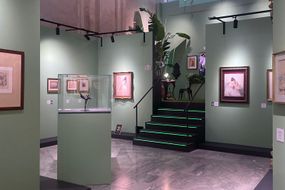From 3 October to 16 January 2022
Scottish painter Douglas Swan was born in the United States in 1930 and died in Bonn in 2000, where he had lived since the mid-1970s. There he worked in the immediate vicinity of August Macke's former home and studio. The August Macke Museum Haus took Douglas Swan's 90th birthday as an opportunity to host a major retrospective for the artist for the first time.
After studying at the College of Art in Dundee (Scotland), Douglas Swan worked for some time in London and Bath with the famous painter William Scott. Under his influence he approached gestural painting, which remained decisive for his work until the mid-1960s.
In 1958 Douglas Swan left for a study trip to Italy. There he comes into contact with exponents of the Italian avant-garde. In Milan around 1966 he began to create object paintings in which he paints highly stylized people, everyday objects and simple geometric shapes on colored monochrome surfaces or - cut from slabs and drawn - assembled as assemblages.
After his successful exhibition in 1967 at the Kunstmuseum Bochum, where Douglas Swan met his future partner Barbara Kückels, he decided to move to Germany and settled in Bonn. However, he regularly returned to Scotland and worked in his parents' home in Carnoustie, where numerous depictions of Scottish coastal landscapes were created.
With his "AIR" technique the artist developed a unique stylistic device around 1970 by repeating parts of a pictorial object on a transparent plastic surface (or cap) a few centimeters above the surface of the painting. Shapes and outlines cast shadows on the painted surface, forming a new image and adding another level of meaning to the work.
In the course of his further work, Douglas Swan refined the method of repetition and variation of the objects depicted in the image. Based on his extensive knowledge in the field of classical music, he also incorporated principles of musical composition - such as sonata form or fugue - into his painting projects.
The artist also applied these principles in the 1980s in some paintings in which he varied works of art by famous masters, such as B. Jan Vermeer or August Macke. As a result, a group of works on musical pieces by well-known composers was created in the 90s, i.e. B. Johann Sebastian Bach or Ludwig van Beethoven, some of which are among the most interesting and important works of Douglas Swan.
Douglas Swan's impressive work spanned the entire second half of the twentieth century. Well aware of his Scottish and Celtic roots, he was also deeply rooted in the German art scene. Douglas Swan's best works can be described as timeless in their high pictorial quality and artistic validity - and in that sense he is a modern classic.
The focus of the exhibition at the Museum August Macke Haus is on the artist's period works in Bonn, which is considered the most important phase of his work. He particularly emphasizes the artistic references to August Macke, who shaped Swan's work around 1990. About 70 works by the artist, partly in multiple parts and in large format, have been collected from public and private collections. The attached catalog, with the contributions of Prof. Klaus Honnef and Prof. Dr. Christoph Zusatz, presents for the first time the work in a complete way in its development and subjects it to a historical-artistic re-evaluation.

Hochstadenring 36, Bonn, Germany
Opening hours
| opens - closes | last entry | |
| monday | Closed now | |
| tuesday | Closed now | |
| wednesday | Closed now | |
| thursday | 11:00 - 19:00 | |
| friday | 11:00 - 17:00 | |
| saturday | 11:00 - 17:00 | |
| sunday | 11:00 - 17:00 |

From 15 March to 27 July 2025
From impressionism to modernity

Former Church of Santo Stefano, Mondovì